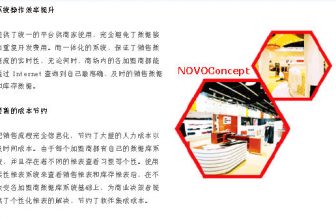
The application of RFID in 6 major industries: logistics, medical, retail, manufacturing, transportation and agriculture
[ad_1]
A small RFID tag (Tag) can attract global attention, mainly because RFID can be widely used in various industries and fields, such as manufacturing, logistics, retail, medical, and aviation industries, all of which can pass RFID Active and passive information collection to solve their original process and management problems.
According to a survey conducted by the Office of the Ministry of Economic Affairs’ Radio Frequency Identification (RFID) Public Domain Promotion Office, the key application areas of Taiwan’s RFID in the future are logistics, medical care, retail, manufacturing, passenger transportation, and animals and plants. Chips and other fields. Therefore, this article will focus on six major industries including logistics, medical care, retail, manufacturing, passenger transportation, and agriculture, and introduce in detail the main application modes of RFID in various fields.
The application of RFID in the logistics industry-a race against time RFID helps the logistics industry accumulate “seconds” into “time”
“Since the popularization of RFID, it was initially mainly used in logistics applications,” said Li Zhengming, deputy director of the RFID Public Domain Application Promotion Office of the Ministry of Economic Affairs. In order to allow enterprises to exchange and share information between enterprises, RFID has become an important technology in the logistics industry. one. At present, major express and logistics companies in the world are very interested in RFID technology, including international express companies FedEx (FedEx) and UPS, which are actively conducting research and development on RFID. In Taiwan, Hsinchu Freight has already In addition, Dongli Logistics is also actively planning the possibility of introducing RFID in finished vehicles after assisting Ford Liuhe Motors to introduce RFID in the logistics application of auto parts.
Linda Brigance, Chief Information Officer of FedEx Asia Pacific, pointed out that FedEx has been testing RFID products and technologies since 1977. The testing scope covers shipment packaging and scanning, so as to understand how shipments are tagged with RFID tags. After that, whether the cargo scanning can be made easier and more reliable. However, due to the high price of tags and the problem of less than 100% read rate, FedEx has not yet fully introduced RFID in the enterprise, and only applies RFID in a few feasible places.
As early as 2000, FedEx adopted a keyless entry and ignition system (keyless entry and ignition system). When a FedEx carrier returns to the truck, the system uses a sticky wristband equipped with an RFID transceiver. Tap the RFID button on the wristband to open the door and start the engine. Linda Brigance said that each door of the truck is equipped with a keyless door opening and activation system composed of RFID scanners, and a scanner is also installed at the truck activation switch. When the operator’s transceiver wristband approaches the scan Within 6 feet of the device, the system compares the code in the wristband with the code of the transceiver. Once the comparison matches, the driver’s door will automatically unlock.
This application is mainly to save the time of the operator using the car key. Although it is only a few seconds each time, if the operator stops hundreds of times a day, the accumulated time saved is also considerable. The extra time is all Can be converted to transport more goods. There are already more than 2,000 FedEx trucks equipped with this system.

Caption: When a FedEx operator returns to the truck, he only needs to press the RFID button on the wristband, and the car door will automatically open and start the engine automatically. (Provided by Bloomberg)
In addition to the above-mentioned applications, FedEx has also tested the feasibility of RFID introduction in multiple links, for example, arranging RFID tags on trucks and trucks to monitor the status of trucks entering and leaving the airport cargo terminal. The same technology is also installed in the management system of the delivery yard. As long as the truck passes the scanner, the information of the items on the truck can be automatically updated. Or, in Australia, an attempt has been made to install RFID tags with active reporting data on shipments waiting for customs clearance to automatically check and report the status of shipments waiting for customs clearance. However, after the testing of these two applications, they did not move towards the actual promotion of applications, and FedEx could not disclose the specific reasons.
For the logistics industry, the full use of RFID means affixing RFID tags to all logistics products, and most businesses also hope to do so. However, due to factors such as the high price of RFID tags and the inability to reach 100% read rate, etc. Including FedEx, UPS, Dayong Cargo, Hsinchu Cargo, etc., it is still unable to fully use RFID on logistics products; most of them are still in the evaluation and testing stage. However, despite multiple obstacles, Linda Brigance still believes that RFID technology will eventually be popularized in the logistics industry within a day, and the time point will be about a few years later.
The application of RFID in the medical industry-to protect the safety of patients
“The 21st World Global Medical Care System has begun to emphasize the advancement of patient safety and the improvement of medical quality.” said Jian Shouwei, head of the Information Management Group of the Central-Southern District Alliance of the Department of Health and the Taichung Hospital Information Division of the Department of Health of the Executive Yuan. Integrating RFID technology into medical information systems has become a trend.
In the medical field, RFID can be applied in almost all aspects of hospitals. Taiwanese hospitals began to use RFID when the SARS outbreak began in 2003. At that time, Hsinchu Dongyuan Hospital used RFID to record the movements of medical staff and patients in detail to avoid the epidemic. diffusion. Since then, various hospitals have successively introduced RFID, and the Taipei Medical University affiliated hospital completed the construction of the “SARS Hospital Epidemic Prevention and Quarantine Tracking System” in 2004. Liu Li, deputy dean of information at the Taipei Medical University affiliated hospital, said that after SARS, various applications of RFID in hospitals have been developed.
“RFID has a wide range of medical applications,” said Xu Tiancheng, director of the Information Department of Changhua Christian Hospital, including blood bag management, medical record management, valuable instrument tracking, waste tracking, emergency rescue tracking, home care monitoring, patient identification, and operating room. RFID technology can be added to management, nursery management, drug logistics management, access control management, etc. to improve incident handling.
Since RFID can be applied to so many links, in which link should the hospital first introduce RFID? Many hospital CIOs believe that improving patient safety is the first priority. However, improving patient safety still involves multiple links. For example, blood bag management, operating room management, medication safety, and infectious disease patient tracking are all for patient safety. At these levels, the most urgent application is undoubtedly the tracking of patients with infectious diseases; as for medication safety, it is the key application that many hospitals consider the most feasible and effective.
1. RFID tracks patients with infectious diseases to avoid the spread of the epidemic
In the past, RFID was used to prevent the spread of SARS. It is an important thing to discover the whereabouts of patients with infectious diseases. In addition to preventing the spread of SARS in the past, Taichung Hospital has also used RFID for tuberculosis patients. In terms of management, Jian Shouwei said that there are some difficulties in the management of tuberculosis patients, because based on human rights, patients cannot be denied access to visits and walking in the ward. Therefore, there have been cases in hospitals where open and multi-drug resistant tuberculosis patients are forced to treat patients and use their family members. Escape from the ward during the meeting time, this kind of problem may cause the spread of germs.
Faced with such a situation, RFID can be used to improve, such as the use of active RFID tags in the patient, the system can actively detect whether the patient is in a specific ward area, and automatically record the contact history of the nursing staff and the patient, and the nursing staff can warn the patient Abnormal messages, even if the patient removes the RFID bracelet, the system can also detect it.
2. RFID for patient identification improves medication safety
Why is improving drug safety so important? Huang Yuanjie, director of the Information Office of the General Hospital of the Tri-Services, cited information from the Department of Health and pointed out that in 2004, the medical center had 3,144 medication errors and the regional center had 4,398 medication errors. The average cost of remediation of each error was about NT$100,000. That is to say, excluding the data of local hospitals and clinics, Taiwan hospitals lose nearly 1 billion yuan every year due to the wrong medicine. However, the financial loss is small. The patient’s life is caused by the nurse giving the wrong medicine. Safety cannot be ignored.
Jian Shouwei said that there are currently four major problems in the safety of medication in hospitals: 1. The traditional bracelets of patients are easy to be blurred and difficult to identify. 2. Medical staff work offline and cannot know that the doctor’s order has been changed. 3. It is easy to miss the job afterwards. 4. Complicated manual operation with high error rate.
Jian Shouwei further pointed out that using a mobile nursing car that combines RFID, UD drug pack barcode reading devices and integrated with the nursing system. Because RFID can allow the patient identification rate to reach 100%; the mobile nursing car can provide the most real-time medical advice information; the real-time nursing information can allow nurses to check patient and drug delivery, provide timely medication information and on-site nursing records, greatly reducing labor Error rate, in addition, the movement of nursing staff can be recorded by RFID, and the standard operating procedure (SOP) of nursing operation can be implemented.

Caption: The hospital uses mobile nursing vehicles, RFID technology, and integrates the hospital care system to allow nurses to repeatedly confirm patients and check medicines during the process of administering medicines to patients, thereby improving patient medication safety. (Photo by Liu Lihui)
The application of RFID in the retail industry-anti-theft, no shortage of goods RFID helps the retail industry reduce losses
Since Wal-Mart vigorously promoted RFID, the use of RFID technology in the retail industry has been in full swing around the world. Li Zhengming analyzed and pointed out that the retail industry is facing four major problems in operation, such as high labor costs, theft, difficult inventory management, and out of stock in stores. Among them, the loss caused by theft and out of stock should not be underestimated.
According to a survey conducted by the American Retail Loss Prevention Association, the US retail industry loses up to 30 billion U.S. dollars each year due to theft, accounting for about 4 to 5% of the US retail industry’s total revenue. In fact, the theft problem exists in the retail industry of all countries in the world. In addition, the reduced revenue due to the stock-out problem is also considerable. Calculated on the basis of Wal-Mart’s annual revenue of approximately US$300 billion, the loss of 4% of the turnover due to the stock-out problem is approximately US$1.2 billion.
Faced with many problems, major retailers all over the world expect to be improved through information technology, and RFID has become one of the preferred technologies. Ji Junde, manager of the Business Support Department of NEC System Business Group, believes that the application of RFID in the retail industry can be divided into two parts. One is the “warehouse-side purchase and inventory management” for logistics support applications. The main purpose is to improve the efficiency of purchase acceptance. As well as correctness and visibility of inventory, the second is “store-side customer service and sales” for customer service applications, which aims to improve customer relationship management, fast checkout, anti-theft, price checking, product history, and promotion efficiency, etc. Operation.
If distinguished by goal orientation, Li Zhengming divides the retail industry’s application of RFID into three major directions:
1. Improve internal work efficiency: Wal-Mart and Bust Buy are examples of this category.
The main purpose of Wal-Mart’s introduction of RFID is to prevent shortages, improve the efficiency of inventory operations, and make inventory transparent. In January 2005, the company required the top 100 suppliers to put RFID tags on their products, and in January 2006 The month expanded to the top 300 suppliers, and in 2007 it increased to the top 600 suppliers. So far, the shortage rate has been reduced to 16%, and the operator’s ordering cost has been reduced by 10%.
Bust Buy asked major suppliers to use RFID tags on products in January 2006, and expanded to all suppliers in May 2007. The main purpose is to improve warehouse management optimization and store operation efficiency. The company expects RFID It will increase the work efficiency of employees by up to 5 times compared with the use of bar codes.
2. Let customers have a better shopping experience: Japan’s Takashimaya introduced RFID for this purpose.
Takashimaya Department Store started a test plan to use RFID in merchandise management in 2005. In addition to hoping to improve work efficiency through RFID, the biggest goal is to improve customer satisfaction and increase merchandise sales. It was officially introduced into the store in September 2006, and RFID is currently applied to products including ladies’ shoes, men’s shirts, and cosmetics (lipstick).
3. Become a leader in product launches: it belongs to GAP, a well-known American apparel retailer.
Through RFID identification, GAP manages the best-selling jeans in the product. By tracking the purchase and sales of different styles in real time, it can quickly grasp the market trend and make correct purchasing judgments to make itself a leader in the product.
Through RFID, there will be different types of workflows in the retail industry, from restocking, inventory counting, shelf, customer service to checkout, there will be different management and service forms, that is to say, RFID will enable the retail industry to move into the future shop.

The application of RFID in the manufacturing industry-the current use of process improvement to help green recycling in the long run
When retail giants such as Wal-Mart and Bust Buy require suppliers to affix RFID tags to their products, this requirement has also affected manufacturers to start using RFID. Li Zhengming said that in the face of the requirements of downstream customers, upstream The manufacturing industry obviously has to start using RFID. Since it had to be done only out of customer requirements at the beginning, in order to save costs (labels are expensive after all), most manufacturers just put labels on the outer boxes of their products, and many manufacturing industries even entrust this work to the logistics industry.
However, with the gradual reduction of RFID tags, and computer manufacturers such as Dell and HP, they also have to introduce RFID on the components according to the requirements of some major component (Key component) manufacturers. Take the computer as an example. , Expensive panels will be the first target for manufacturers such as HP, and even upstream panel suppliers, such as backlight panel manufacturers, may also be required to use RFID. Due to a number of factors, some manufacturers have begun to introduce RFID into their internal manufacturing processes.
Hewlett-Packard (HP) Asia Pacific Service Office RFID and Supply Chain Asia Pacific Technology Center Associate Zhou Mingpei pointed out that Taiwan’s optoelectronics industry is already in the process of RFID introduction. Take a panel manufacturer in Taiwan as an example. The company’s RFID application model is to use RFID technology on the production line of the factory, and record the components used on the production line through RFID. The key stations on the production line are equipped with RFID readers. , To build a complete Quality Assurance (QA) resume, and which operator is responsible for each operation station is also recorded in detail. In this way, it includes components, production lines, QA, people and time, etc. and products The elements related to the process are all recorded in detail and comprehensively.
Zhou Mingpei further pointed out that when the manufacturing industry introduces RFID in the production process, the industry can fully grasp the product flow and status, for example, which upstream supplier the component comes from, and what is the batch number? Which production line is the finished product produced? What is the verification procedure for the product? …And other information can be fully grasped. In this way, regardless of whether the product is detected with a problem before or after shipment, it can be tracked back to understand where the problem occurred and quickly solve the problem. Of course, not only the electronics manufacturing industry can be used in this way, the same applications can also be used in the automotive and pharmaceutical industries.
The manufacturing industry uses RFID on its products, as well as to avoid malicious return of unscrupulous consumers and in response to the requirements of the green supply chain, to avoid the recycling of products that are not their own. For example, Li Zhengming said that when a mobile phone or notebook computer made in Taiwan is sold to consumers, consumers may request to return the product as a bad product. However, some companies will face the recycled product. Only the shell is their own. Others The internal components do not belong to the original factory, which leads to a lot of losses. Before there was no RFID, the industry usually could not imagine. However, if the RFID is used for authentication when returning the goods, it can be confirmed whether it is a company product once scanned by the reader. .
There are many applications of RFID in the manufacturing industry. In addition to the use of RFID in finished products and production lines as a follow-up product circulation tracking application, Liu Yingchang, director of the Zhenglong RFID Application Testing Center, pointed out that, on the whole, RFID is roughly There are 4 major applications. 1. Supply Chain Management (Supply Chain Management; SCM). 2. Product control (Work-in-Process; WIP) tracking. 3. Asset Management. 4. Security and access control.

Caption: Despite the high price of RFID tags, LCD manufacturers have recently adopted recyclable RFID tags and applied RFID in the production line. (Provided by Bloomberg)
Application of RFID in transportation and transportation industry-RFID follows passengers and luggage globally to speed up customs clearance operations
While manufacturing, logistics, and retail companies are still testing RFID, in fact RFID has long been used in passenger transportation. The most familiar application is the leisure card for bus and MRT. Its built-in The chip is using RFID technology.
In addition, in aviation, RFID also has many applications. Zhou Mingpei said that the main applications are RFID passports, RFID visas, and passenger luggage transportation. RFID technology is used in the passport to load name, nationality, gender, and date of birth. , Birthplace, passport holders, and digital photos are already underway, including the United States and Japan. In the same way, RFID can also be used on visas.
At present, the most widely used in the aviation industry is the use of RFID for luggage transportation at airports. At present, many airports in the world have introduced RFID for luggage transportation. Hong Kong International Airport is the most famous example. Hong Kong Chek Lap Kok International Airport in 2005 Establish an RFID baggage sorting system to increase the speed of the baggage handling process: the application mode process is: when passengers check in their baggage at the check in counter, there is no problem with the baggage inspection → directly to the conveyor belt → the machine affixes the RFID tag → will Write the Baggage Service Message (BSM) of the International Air Transport Association (IATA) into the RFID tag → send it to the baggage sorting system via the conveyor belt for classification → when the baggage arrives at the flight door, the RFID reader confirms it Whether it is the correct baggage and whether the number of pieces of baggage is correct. In Taiwan, Taoyuan International Airport is also building passenger baggage management.

Caption: Hong Kong International Airport is the first airport in the world to adopt a point-to-point RFID baggage picking system. After passengers check in their baggage, the baggage is affixed with RFID tags. (Provided by Bloomberg)
The application of RFID in agriculture-assisting in the transformation of agriculture
For RFID technology, agriculture is actually a very important application field, including Japan, the United States, Canada, Australia, the Netherlands, and Taiwan, all of which actively use RFID technology to enhance agricultural competitiveness. From the perspective of the application of RFID promoted by the Taiwan Council of Agriculture, agricultural applications of RFID can be roughly divided into three categories, namely production management, transportation and sales management, and safety management.
1. Production management application case-Phalaenopsis
The most typical example of Taiwan’s production management is the application of RFID to the production management of Phalaenopsis. Liao Anding, Director of the Planning Division of the Executive Yuan Agriculture Committee, pointed out that the Phalaenopsis industry is a relay production model and the process is very complicated: the bottle seedling production stage takes about 1 year. Half a year, it will take about one year for the 1.5-inch seedlings to grow to 3.5 inches after being bottled. In the bottle seedling room and the temperate world, there are millions of bottle seedlings and seedling plants of different development stages, huge greenhouse area and bottle seedlings. Quantity, must spend huge manpower and time to manage.
There are multiple problems in management, such as the timing of breeding operations that need to be instructed by professionals; manual inventory is labor-intensive and accurate; it is impossible to control the latest inventory information in a timely manner, which affects business opportunities; and it is difficult to respond and improve immediately when the production and sales of orchid seedlings are missing. . These problems can be improved as much as possible through RFID technology, such as the use of RFID to find the correct position of the seedling bottle, so that operators can quickly and correctly perform cultivation operations, and the use of temperature-sensitive RFID to record product batch numbers and the entire transportation temperature.
2. Application case of transportation management-Chilean avocado
From picking to consumers, agricultural products need to go through many links such as large-cap business, mid-market, small-cap business, etc. How to make agricultural products still delicious and fresh when delivered to consumers is an important issue in agriculture. The quality of agricultural products is maintained as much as possible during the transportation process, and RFID technology can also be used to complete it. Chilean company Rio Blanco uses RFID technology in avocados to ensure the quality and freshness, but it is still in the experimental testing stage.
Rio Blanco wrapped 20 unpicked avocados with RFID temperature-sensitive tags in April 2007, and packed them in cartons after being picked. As a result, they were transported from Chile to California during the 6,000-mile transportation journey. The whole temperature record can be obtained by reading the label, so that the freshness of the avocado can be grasped at any time.
3. Application case of safety management-production and sales history
In the face of endless food safety incidents, how to improve food safety has always been the work of governments of all countries. With RFID technology, the use of RFID to improve food safety has become one of the important methods. In Taiwan, the agricultural product production and marketing resume actively promoted by the Council of Agriculture will introduce RFID technology in the future. Lin Zhen, director of the Information Center of the Council of Agriculture, said that the production and marketing resume platform will simultaneously use one-dimensional barcodes, mobile barcodes and RFID technologies. Among them, RFID is mainly used to provide complete product records and improve the safety of agricultural products. However, because the label is too expensive and the reading rate cannot be optimized when it encounters water, metals and other substances, the current production and sales history of the Council of Agriculture only uses one-dimensional barcode and mobile barcode technology.
Under the active leadership and promotion of the government in Taiwan, the agricultural sector will actively adopt RFID technology in the future. Liao Anding pointed out that the main purpose of using RFID technology in agriculture is to promote agricultural transformation and upgrading and enhance agricultural competitiveness.
There are still multiple problems to be solved in the application mode
Although RFID technology is indeed the future trend, there are still many problems that need to be solved in order to be fully popularized and promoted, including read rate issues, tag prices, RFID technical standards and compatibility issues, privacy protection, etc. RFID related industries continue to work hard to improve the direction.
However, even if there are multiple technical problems to be solved, the mature RFID application model does bring a dawn to the popularization and application of RFID. As for whether to use it, it must be evaluated and judged by each enterprise itself. Import and import.
[ad_2]






